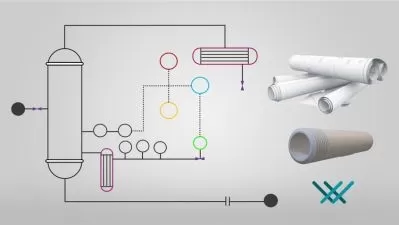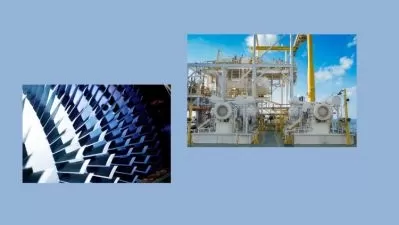Static Modeling in Petrel
Waqas Arif
43:38
Description
Mastering Reservoir Characterization and Decision-Making through Static Modeling in Petrel
What You'll Learn?
- Understand the fundamentals of reservoir static modeling: Students will gain a solid foundation in the principles and concepts of reservoir static modeling.
- Master the Petrel software for reservoir static modeling: Students will become proficient in using the Petrel software, a leading industry tool.
- Construct realistic reservoir models: Students will learn the techniques and best practices for constructing realistic reservoir models in Petrel.
- By the end of the course, students will have the knowledge and skills to confidently create, analyze, and validate reservoir static models in Petrel.
Who is this for?
What You Need to Know?
More details
DescriptionThe Reservoir Static Modeling in Petrel Course is an in-depth program designed to provide participants with the knowledge and skills necessary to create accurate and reliable static models of underground reservoirs using the industry-standard Petrel software. Through a combination of theoretical lectures, practical exercises, and hands-on projects, participants will gain a comprehensive understanding of reservoir static modeling principles, techniques, and best practices.
Course Objectives:
Understand the role and importance of reservoir static modeling in reservoir characterization.
Gain proficiency in using the Petrel software, including navigating the interface, and utilizing relevant modules and functionalities.
Learn how to construct realistic reservoir models by integrating geological, geophysical, and engineering data, and applying grid construction and property modeling techniques.
Course Outline:
List of Required Dataset
Structural Framework Construction
Fault Modeling (Pillar Gridding)
Horizon Modeling
Grid Construction: Techniques for creating structured and unstructured grids in Petrel.
Property Modeling: Estimating and assigning petrophysical properties to reservoir models.
Who Should Attend:
Reservoir Engineers involved in reservoir characterization.
Geoscientists, including geologists and geophysicists, working with subsurface data and contributing to reservoir modeling.
Petroleum Engineers engaged in reservoir simulation and field development planning.
Students pursuing degrees or conducting research in reservoir engineering, geology, or related disciplines.
Prerequisites:
Basic knowledge of reservoir engineering and geology concepts is recommended.
Familiarity with Petrel software is beneficial, but not mandatory.
By the end of this course, participants will be equipped with the skills and knowledge to confidently create, analyze, and validate reservoir static models in Petrel. They will be well-prepared to contribute effectively to reservoir characterization projects and make informed decisions to optimize reservoir performance.
Who this course is for:
- Geoscientists: Geoscientists, including geologists and geophysicists ,
- Reservoir Engineers,Petroleum Engineers, Students and Researchers
The Reservoir Static Modeling in Petrel Course is an in-depth program designed to provide participants with the knowledge and skills necessary to create accurate and reliable static models of underground reservoirs using the industry-standard Petrel software. Through a combination of theoretical lectures, practical exercises, and hands-on projects, participants will gain a comprehensive understanding of reservoir static modeling principles, techniques, and best practices.
Course Objectives:
Understand the role and importance of reservoir static modeling in reservoir characterization.
Gain proficiency in using the Petrel software, including navigating the interface, and utilizing relevant modules and functionalities.
Learn how to construct realistic reservoir models by integrating geological, geophysical, and engineering data, and applying grid construction and property modeling techniques.
Course Outline:
List of Required Dataset
Structural Framework Construction
Fault Modeling (Pillar Gridding)
Horizon Modeling
Grid Construction: Techniques for creating structured and unstructured grids in Petrel.
Property Modeling: Estimating and assigning petrophysical properties to reservoir models.
Who Should Attend:
Reservoir Engineers involved in reservoir characterization.
Geoscientists, including geologists and geophysicists, working with subsurface data and contributing to reservoir modeling.
Petroleum Engineers engaged in reservoir simulation and field development planning.
Students pursuing degrees or conducting research in reservoir engineering, geology, or related disciplines.
Prerequisites:
Basic knowledge of reservoir engineering and geology concepts is recommended.
Familiarity with Petrel software is beneficial, but not mandatory.
By the end of this course, participants will be equipped with the skills and knowledge to confidently create, analyze, and validate reservoir static models in Petrel. They will be well-prepared to contribute effectively to reservoir characterization projects and make informed decisions to optimize reservoir performance.
Who this course is for:
- Geoscientists: Geoscientists, including geologists and geophysicists ,
- Reservoir Engineers,Petroleum Engineers, Students and Researchers
User Reviews
Rating
Waqas Arif
Instructor's Courses
Udemy
View courses Udemy- language english
- Training sessions 7
- duration 43:38
- Release Date 2023/07/31
















